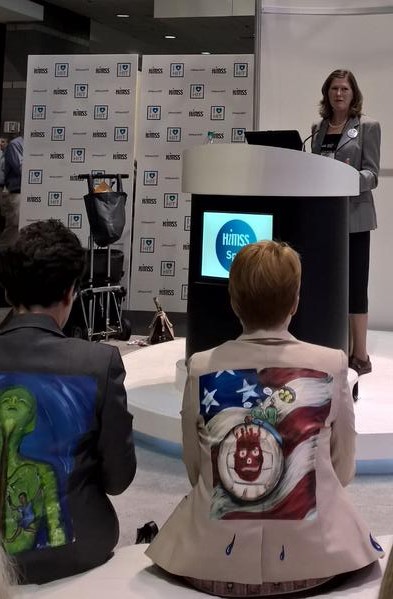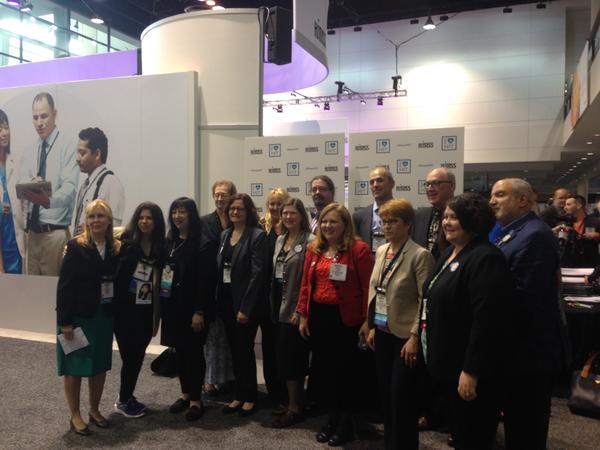Data Was Big at HIMSS15

Since I attended my first HIMSS in 2010, my consistent theme has centered on the fact that implementing EHRs with some standard functionality was a necessary precursor to achieving the core goals associated with improving quality and increasing the value of the healthcare we provide to individuals and groups. Having the ability to track and analyze outcomes in a systematic fashion benefits medical researchers, payers, patients, and policy makers (Pharma and device companies, too), not just providers.
HIMSS15 confirmed that the spotlight is now on data—and what can be done with digital data. In other words, we’ve moved on from the era of adopting EHRs to the era of leveraging the data collection and reporting capabilities of EHRs. To someone who has been a champion of “meaningful use” of EHR data through the rough times of less-than-perfect EHR platforms, I feel as though the HIMSS universe is finally reaching the stage where the benefits of putting outcomes data to work via software solutions are apparent.
Marc Andreessen said that “software is eating the world”, but from my perspective software isn’t of any use without the data to fuel the software engine.[1]
Granted, we haven’t entirely said goodbye to issues related to basic EHR architecture, usability, and interoperability, but the spotlight has shifted to what can be done when the data generated by EHRs and other sources. Note, it goes without saying that careful data management is required throughout the entire process of generating, analyzing, integrating, sharing and reporting data.
In a follow-on post, I’ll dive more deeply into some of the clinical decision support solutions I saw at HIMSS15. For this post, I’ll stay at 35,000 feet and review the HIMSS15 experience relative to my expectations.
A couple of months prior to HIMSS15, I was asked by the HIMSS Social Media organizers what top trends I expected to see at HIMSS15. I narrowed it down to three topics:
- More advanced uses of population health data.
- Consolidation in the health IT segment led by enterprise software vendors.
- Evidence of 2015’s becoming the “The Year of Patient Decision Tools”.
I’d say I scored a 2.5 out of 3, but let me explain in case you don’t see things through my lens.
On the first trend, I don’t think anyone would argue against the point that population health applications and analytics were at the top of the list of buzzwords at HIMSS15.
Regarding the continued relevance of the Meaningful Use program, I’ve argued in the past that we’ll know that we’ve made progress when we no longer need external regulations to drive optimal design and use of health IT systems. At the current time, healthcare providers are still largely driven by external regulations, except we’re moving from ONC-driven EHR adoption incentives to CMS reimbursement/payment-driven policies. Long-term changes in payment/reimbursement and delivery models will have a stronger impact on IT priorities of providers than a short-term incentive program like the Meaningful Use program.
On number 2, the consolidation theme, this is what I wrote prior to HIMSS15:
Just about everyone expects consolidation among the fragmented EHR vendor segment; but I predict that we’ll start to see some EHR vendors acquired by large multi-industry enterprise resource planning (ERP) vendors, such as SAP or Oracle. The large vendors have experience integrating multiple systems and already have some experience in healthcare with financial and talent management software systems. It doesn’t take a big stretch of the imagination to envision further integration with clinical systems, especially in light of new payment models where financial performance is a function of clinical performance.
It’s a shame I didn’t include IBM in my list of large multi-industry enterprise vendors, since one of the biggest announcements was the acquisition of Explorys and Phytel by IBM for its Watson Health unit. [2]
Although Watson Health isn’t an ERP solution, it is part of a large corporation that provides multiple solutions to provider organizations. Furthermore, IBM is more entrenched in the business side of the spectrum and building up Watson Health represents an investment on the clinical side of the spectrum. My overarching point is that new reimbursement models are driving the need to close the divide between admin systems and clinical systems. New reimbursement models tie financial outcomes to clinical outcomes, so admin and business intelligence systems need to integrate clinical outcomes data.
On point 3, with my optimist hat on, I predicted that HIMSS15 would highlight patient decision tools, not only decision tools designed for clinicians. I did see some impressive communications and decision tools for patients, including GetWell:) Network and Tonic, which has partnered with Elsevier to market its patient engagement solution. There were other patient engagement & decision tool vendors at HIMSS15, and this topic merits more attention. For now, I’ll stick with my prediction that in 2015 we’ll see a lot of activity in the patient decision tool space and I will provide more indepth coverage later.
Finally, I’d like to thank HIMSS for including me in the Social Media Ambassador program this year. It was terrific to be grouped with the elite digerati in health IT and healthcare. This is a forward-thinking group that generously shares their insights via social media.
I’ll wrap up with a few photo highlights from my HIMSS15 experience.

The awesome Social Media Ambassador group for HIMSS15. Nearly all long-time health IT social media friends, along with a couple of new connections for me.

Meetup of #TheWalkingGallery members at the #IHeartHIT session on Monday, April 13, 2015.

Last, but not least, the HIMSS experience always extends into the evening. Here’s one of my favorite pictures, a group selfie taken by @DrNic1 at John Lynn’s #HITMC meetup at Gino’s East on Tuesday, April 14, 2015, with @DrNic1, me, @OchoTex and @askJoyRios, photo-bombed by @DocWeighsIn and @SarahBennight:

Stay tuned for additional posts on HIMSS15 that will cover developments in Clinical Decision Support.
[1] Marc Andreessen, Wall St. Journal, August 20, 2011:http://www.wsj.com/articles/SB10001424053111903480904576512250915629460, accessed April 23, 2015.
[2] http://www.healthcareitnews.com/news/ibms-big-buy, accessed April 23, 2015.
 Janice McCallum
Janice McCallum